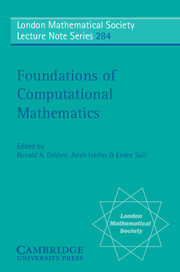Book contents
- Frontmatter
- Contents
- Preface
- Singularities and computation of minimizers for variational problems
- Adaptive finite element methods for flow problems
- Newton's method and some complexity aspects of the zero-finding problem
- Kronecker's smart, little black boxes
- Numerical analysis in Lie groups
- Feasibility control in nonlinear optimization
- Six lectures on the geometric integration of ODEs
- When are integration and discrepancy tractable?
- Moving frames — in geometry, algebra, computer vision, and numerical analysis
- Harmonic map flows and image processing
- Statistics from computations
- Simulation of stochastic processes and applications
- Real-time numerical solution to Duncan-Mortensen-Zakai equation
Adaptive finite element methods for flow problems
Published online by Cambridge University Press: 05 August 2013
- Frontmatter
- Contents
- Preface
- Singularities and computation of minimizers for variational problems
- Adaptive finite element methods for flow problems
- Newton's method and some complexity aspects of the zero-finding problem
- Kronecker's smart, little black boxes
- Numerical analysis in Lie groups
- Feasibility control in nonlinear optimization
- Six lectures on the geometric integration of ODEs
- When are integration and discrepancy tractable?
- Moving frames — in geometry, algebra, computer vision, and numerical analysis
- Harmonic map flows and image processing
- Statistics from computations
- Simulation of stochastic processes and applications
- Real-time numerical solution to Duncan-Mortensen-Zakai equation
Summary
Abstract
We present a general approach to error control and mesh adaptation for computing viscous flows by the Galerkin finite element method. A posteriori error estimates are derived for quantities of physical interest by duality arguments. In these estimates local cell residuals are multiplied by influence factors which are obtained from the numerical solution of a global dual problem. This provides the basis of a feed-back algorithm by which economical meshes can be constructed which are tailored to the particular needs of the computation. The performance of this method is illustrated by several flow examples.
Introduction
Approximating partial differential equations by discretization as in the finite element method may be considered as a model reduction where a conceptually infinite dimensional model is approximated by a finite dimensional one. As the result of the computation, we obtain an approximation to the desired output quantity of the simulation and besides that certain accuracy indicators like cell-residuals. Controlling the error in such an approximation of a continuous model requires to determine the influence factors for the local error indicators on the target quantity. Such a sensitivity analysis with respect to local perturbations of the model is common in optimal control theory and introduces the concept of a dual (or adjoint) problem.
- Type
- Chapter
- Information
- Foundations of Computational Mathematics , pp. 21 - 44Publisher: Cambridge University PressPrint publication year: 2001
- 2
- Cited by

